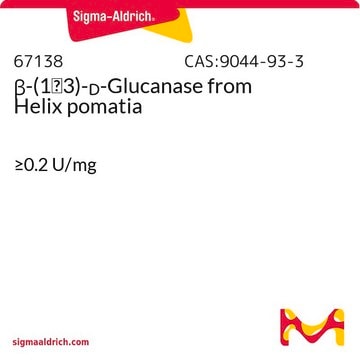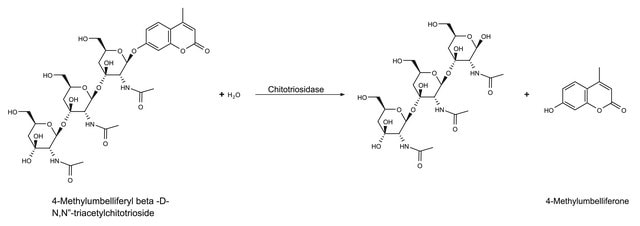C6137
Chitinase from Streptomyces griseus
lyophilized powder (essentially salt free), ≥200 units/g solid
Sinónimos:
N-acetyl-glucosaminidasechitobiase, Chitin digestion enzymes, poly(β-(1→4)-[2-acetamido-2-deoxy-D-glucoside])- glycanohydrolase
About This Item
Productos recomendados
form
lyophilized powder (essentially salt free)
Quality Level
specific activity
≥200 units/g solid
mol wt
30 kDa
solubility
H2O: soluble 0.90-1.10 mg/mL
storage temp.
−20°C
¿Está buscando productos similares? Visita Guía de comparación de productos
Categorías relacionadas
General description
The enzymatic hydrolysis of chitin to N-acetyl-D-glucosamine involves two consecutive enzyme reactions:
- The first reaction, chitodextrinase-chitinase, is a poly(β-(1→4)-[2-acetamido-2-deoxy-D-glucoside])- glycanohydrolase, which removes chitobiose units from chitin.
- The second activity is N-acetyl-glucosaminidasechitobiase, which cleaves the disaccharide to its monomer subunits, N-acetyl-D-glucosamine.
Application
Human health care: Asthma.
Pharma: preparation of chitooligosaccharides and N-acetyl D glucosamine,
Preparation of single-cell protein
Isolation of protoplasts from fungi and yeast
Control of pathogenic fungi
Treatment of chitinous waste, mosquito control and morphogenesis
Biochem/physiol Actions
Features and Benefits
Unit Definition
One new 1 hour unit = approx. 50 old 48 hour units.
Substrate
signalword
Danger
hcodes
pcodes
Hazard Classifications
Resp. Sens. 1
Storage Class
11 - Combustible Solids
wgk_germany
WGK 3
flash_point_f
Not applicable
flash_point_c
Not applicable
ppe
Eyeshields, Gloves, type N95 (US)
Certificados de análisis (COA)
Busque Certificados de análisis (COA) introduciendo el número de lote del producto. Los números de lote se encuentran en la etiqueta del producto después de las palabras «Lot» o «Batch»
¿Ya tiene este producto?
Encuentre la documentación para los productos que ha comprado recientemente en la Biblioteca de documentos.
Los clientes también vieron
Contenido relacionado
Kits de extracción de proteínas, tampones de lisis celular y reactivos para la solubilización de proteínas de cultivos bacterianos, de levaduras e insectos, así como de cultivos celulares de plantas y mamíferos y muestras de tejidos.
Find cell lysis and protein extraction reagents like cell lysis buffers, protein extraction kits, extraction enzymes, and other lysis enhancers for isolating and purifying proteins.
An overview of cell lysis and protein extraction methods including detergent solubilization, freeze-thaw lysis, osmotic shock, sonication, enzymatic cell lysis, and mechanical disruption techniques such as Dounce, Polytron, and mortar and pestle homogenization.
Cell lysis and protein extraction methods overview various techniques, from detergent solubilization to mechanical disruption, supporting research needs.
Nuestro equipo de científicos tiene experiencia en todas las áreas de investigación: Ciencias de la vida, Ciencia de los materiales, Síntesis química, Cromatografía, Analítica y muchas otras.
Póngase en contacto con el Servicio técnico










